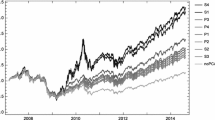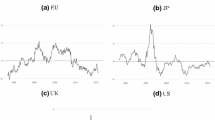Abstract
Among others, fluctuations in market sentiment cause step changes of correlations of financial instrument prices. This phenomenon of the correlations’ destabilization, which was markedly highlighted during the recent financial crisis, reduces the efficiency of the traditional approach to the market risk diversification based on the Markowitz Optimal Portfolio Selection Model. The original Markowitz optimization model represents a convex quadratic programming problem. Almost any efforts to its reformulation involving the above-mentioned facts lead to the loss of a positive semi-definiteness of the matrix occurring in the model’s structure. This leads to a non-convex programming problem whose solution is generally problematic. By refinement of the merits of the original model, we get into trouble with its computational, formal aspect. Therefore, it is necessary to find a way to the reconvexification of the reformulated model. Main objective of the paper is to propose a convex representation of the reformulated model.
Similar content being viewed by others
References
Amenc M, Le Sourd V (2003) Portfolio theory and performance analysis. Wiley, West Sussex
Bazaraa MS, Sherall HD (1993) Nonlinear programming. Wiley, New York
Brandl B, Keber C, Schuster MG (2006) An automated econometric decision support system: forecasts for foreign exchange trades. Central Eur J Oper Res 14: 401–415
Elton EJ, Gruber MJ (2010) Modern portfolio theory and investment analysis. Wiley, New York
Fang Y, Lai KK, Wang S (2008) Fuzzy portfolio optimization. Springer, Berlin
Fernholz ER (2010) Stochastic portfolio theory. Springer, New York
Hasuike T, Ishii H (2009) Probability maximization models for portfolio selection under ambiguity. Central Eur J Oper Res 17: 159–180
Kaplan PD, Savage S (2010) Markowitz 2.0. Morningstar Advisor 4–5: 1–3
Konno H, Yamazaki H (1991) Mean-absolute deviation portfolio optimization and its applications to Tokyo stock market. Manag Sci 37(5): 519–531
Markowitz HM (1952) Portfolio selection. J Finance 7: 77–91
Markowitz HM (1959) Portfolio selection: efficient diversification of investments. Wiley, New York
Rom BM, Ferguson K (1993) Post-modern portfolio theory comes of age. J Invest 2: 27–33
Rom BM, Ferguson K (2001) Using post-modern portfolio theory to improve investment performance measurement. In: Sortino F, Satchell S (eds) Managing downside risk in financial markets, Butterworth-Heinemann Finance, Oxford, 59 p
Vaclavik M (2010) Extension and reconvexification of Markowitz’s optimal portfolio selection model. In: Mathematical methods in economics 2010. University of South Bohemia, Ceske Budejovice, pp 652–657
Author information
Authors and Affiliations
Corresponding author
Rights and permissions
About this article
Cite this article
Vaclavik, M., Jablonsky, J. Revisions of modern portfolio theory optimization model. Cent Eur J Oper Res 20, 473–483 (2012). https://doi.org/10.1007/s10100-011-0227-2
Published:
Issue Date:
DOI: https://doi.org/10.1007/s10100-011-0227-2




